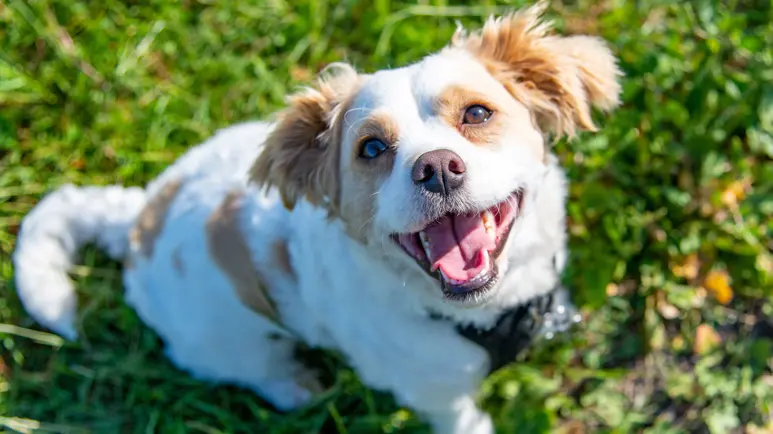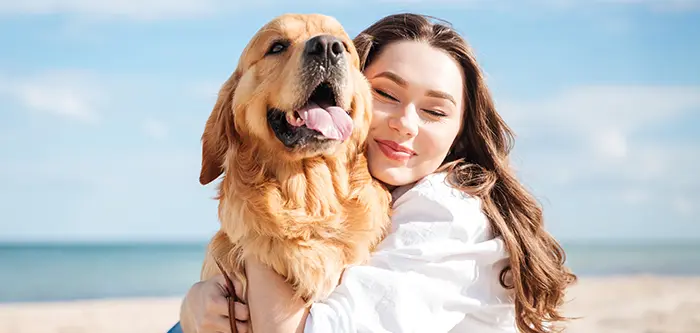Shocking Truth Behind That Doggy Look
Uncover the fascinating truth about what your dog's grin really means.

STORY AT-A-GLANCE
- There’s no doubt many dogs seem to smile, but most canine behaviorists don’t really consider a dog ‘smiling’ to be the same as a human smiling
- Our dogs monitor our behavior and know when we’re happy, and smiling dogs know their grins make us happy
- If your smile seems to trigger a smile in your dog, it’s similar to laughter contagion in humans — your pup ‘catching’ your smile and vice versa
- The “guilt grin” some dogs adopt when they’ve been naughty isn’t actually guilt, but rather submissiveness
- Smiling in dogs could also be a product of “neoteny,” meaning a domesticated dog brings certain puppy behaviors into adulthood
Editor's Note: This article is a reprint. It was originally published May 3, 2024.
Many pet parents are convinced their dogs smile at them, and there are images and videos all over social media featuring dogs with big grins.

Doggy Smiles Make Us Happy, and They Know It
According to veterinarian Dr. Sandra Mitchell, writing for PetMD, “most behaviorists don’t really consider a dog ‘smiling’ to be a true grin in the way we think about a human smile.”1
There are many doggy expressions that resemble a smile, such as wide-mouth panting, relaxing with their tongues out, and submissive grins. Believe it or not, some people even mistake a dog’s aggressive baring of teeth as smiling. But that situation aside, most of the time when dogs appear to be smiling, they are actually happy, and happiness and smiles go hand-in-hand. As Mitchell writes:
“Most scientists think the canine smile stems from a combination of evolution and the fact that dogs are masters of analyzing human behavior. They know exactly how to make us happy. Since most humans react when they see a dog smile — either by smiling back, making approving noises, or providing treats — the dog is rewarded for this behavior and does it more often.”2

Interestingly, it could be that smiling behavior in dogs is a product of “neoteny” — a domesticated dog carries certain puppy behaviors into adulthood — including emotional greetings, jumping, tail wagging, licking, and smiling.
Your Dog May Be ‘Catching’ Your Smile, and Vice Versa
If you’re smiling at your dog and she’s smiling back, Mitchell says she’s not really mimicking your smile, but is simply prompted to smile more in response to you.
“Most dogs really like the happy reaction they get when they please humans and quickly learn how to trigger that happy emotion,” Mitchell writes. “For some dogs, that includes smiling.”
If your smile triggers a smile in your dog, it’s similar to laughter contagion in humans. Just as most of us have had the experience of “catching” someone else’s hearty laughter, a happy smiling human can prompt a happy dog to smile back, and vice versa.

“Most dogs love pleasing their owners and know that smiling is human body language for happiness,” says Mitchell. “The majority of dogs are very good at interpreting human body language. They can tell when we are pleased, sad, or disappointed.
They also know that our happiness often means extra attention, treats, and fun time for them. Not only do they like making us happy, but they like how we treat them when we are happy!
Dogs tend to read the body language that goes along with a human’s smile. They often instinctively understand that smiling and showing teeth is not a human form of aggression (as it might be with other dogs), even if the person is a stranger.”
Guilty Toothy Smiles
You’ve no doubt seen videos of dogs who’ve done something they shouldn’t, and when caught, respond with the toothy “grin of shame.” It looks for all the world like they’re feeling guilty … but are they? Probably not!
It's important to look at more than just your dog’s mouth. Typically, a dog with a toothy grin and lips drawn back, will also lower his head, squint his eyes, flatten his ears, wag his tail, and generally appear submissive (note the dog in the video is lying on her back).
“Grins in response to naughty behavior are not actually signs of aggression nor guilt, but rather submission,” Mitchell writes. “Generally, the dog is aware that you are not happy about something that they did, and they are responding to your emotions. Dogs use submissive grins to defuse aggression and reassure you that they don’t pose a threat.”
10 Signs Your Dog Is Happy
Not all dogs, even happy ones, smile, so again, it’s important to pay attention to your canine BFF’s body language.
- His eyes and eyelids are relaxed, he blinks a lot, his gaze is soft and his brow is smooth. His ears are also relaxed, not cocked or pointing. His mouth is open a bit with a few teeth visible (but not bared), his tongue may be lolling and he may even appear to be smiling.
- She’s holding her body in a relaxed posture vs. a tense or stiff stance. She’s holding her tail high and wagging it with such gusto her whole body is wiggling. Alternatively, her tail may be in a more neutral position, with a softer, slower wag.
- He has no destructive behaviors, even when he’s home alone. Happy dogs generally get plenty of physical and mental stimulation. Bored, under-exercised, under-stimulated dogs are more likely to become destructive, along with dogs who suffer from separation anxiety.
- She loves to play. Happy dogs are always up for a game or a walk or a ride in the car. Since exercise and play are so natural for dogs, if your canine companion doesn’t seem interested, she may be dealing with some pain or an illness, and it’s time to make an appointment with your veterinarian.
- He’s belly-up and tongue out. Happy dogs tend to show their bellies and tongues as they wriggle around on their backs. Happy belly displays are different from submissive belly rolls in which the dog’s mouth is usually closed and his body is stiff.
- Her appetite is good, which indicates she’s both happy and feeling physically well. A noticeable decrease (or increase) in your pet’s appetite can be a symptom of an underlying condition.
- He’s happy barking. Some dogs rarely bark, but those who do tend to have a higher-pitched bark when they’re happy that usually doesn’t last long.
- She play bows. Many happy dogs raise their backsides in the air and lower their chests to the ground as an invitation to play with either their favorite human or a doggy friend.
- He leans into you. A happy dog will often lean into your hand when you pet him and lean into or keep contact with your body whenever the opportunity presents itself.
- She’s thrilled to see you. Happy dogs are without fail excited to see their human come through the door, even if said human has only stepped outside for a minute to check the weather!











